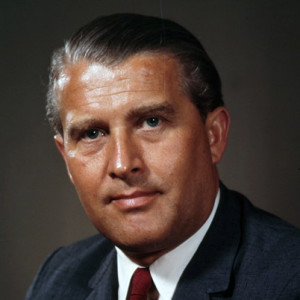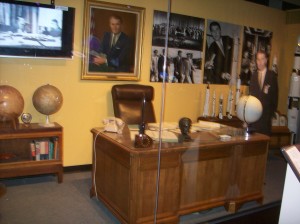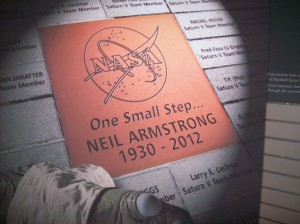“I want to devote my future work to the progress and strength of Western Civilization, and I consider the United States to be the bulwark.” This is a quote from Wernher von Braun upon arriving to the United States. This post will feature a timeline of von Braun’s life in the USA. Because his life was was entwined with the development of US space travel, highlights of the history of space flight will also be featured.
DR. WERNHER VON BRAUN
Fort Bliss, Texas was the first stop in the US for Dr. von Braun and the Paperclip Scientists. Their mission at this time was the development of missiles for the Department of Defense. The missiles were tested at White Sands, New Mexico. Missiles are still tested in the New Mexican desert to this day. They had little contact with the outside world due to the secrecy of their project. Dr. von Braun referred to themselves as the “Prisoners of Peace.”
In 1946, Wernher wrote to his father and inquired whether the hand of Maria von Quistorp was available for marriage. When he asked her to marry him, this was her romantic reply, “I had never thought of marriage with anyone else.” They were married on March 1, 1947 in Germany.
The Secretary of the Army approves the reactivation of the Army’s Redstone Arsenal in Huntsville, Alabama on October 28, 1949. The purpose was to consolidate rocket activities. Wernher von Braun and the Paperclip Scientists are moved to Huntsville, AL in 1950. The Army Redsone Missile was the first large scale ballistic missile for the US. It was designed by Wernher von Braun, based mostly on the design of the V2 missile.
All of the Paperclip scientists had a library card from the Huntsville Library within ONE day of moving here. Many of them remarked they liked Huntsville because the Appalachian foothills in the area reminded them of Bavaria. If I may insert an editorial comment here….Bavaria Germany does not have the hellish heat of an Alabama summer.
Dr. von Braun is featured in Colliers magazine in 1952. His article has artwork of what futuristic space travel and missions to moons and planets would look like. These pictures ignite the imagination of Americans. It becomes “way cool” to be a fan of space travel.
Huntsville High School auditorium was the place where Dr. Wernher von Braun and the Paperclip Scientists were sworn in as American citizens on April 14, 1955.
Humiliation! The Soviet Union beats the US into orbit with the launch of Sputnik 1 on October 4, 1957. The satellite is the size of a beach ball and transmits a continuous “beep beep” signal for 22 days. The US launches Explorer 1 on January 31, 1958. THE SPACE RACE HAS BEGUN!
Hallelujah! President Eisenhower established the National Aeronautics and Space Administration (NASA) on July 29, 1958. It is officially activated on October 1, 1958. Both my husband and I were not even born when this happened. Adam would eventually work for NASA, thus enabling us to pay our mortgage. Thank you very much President Eisenhower!
On September 8, 1960, President Eisenhower formally dedicates the site of Adam’s future employment in Huntsville, AL: The NASA-Marshall Space Flight Center (MSFC), named after the late Secretary of State, George C. Marshall. Dr. Wernher von Braun is named Director of the MSFC. Once again, thank you President Eisenhower!
DR. VON BRAUN’S OFFICE FURNITURE
Soviet Cosmonaut, Yuri Gagarin becomes the first human in space on April 12, 1961. Gagarin circles the Earth in Vostok 1 for 108 minutes after lift-off.
Astronaut Alan Shepard reaches altitude of 116 miles in the Freedom 7 capsule on May 5, 1961, becoming the first American in space.
President Kennedy issues the challenge to go to the moon before the end of the decade on May 26, 1961. Congress issues over 1 billion dollars for NASA. The Moon Program will be known as APOLLO.
Prior to this famous speech, von Braun informed Kennedy, “If we can’t beat them in earth orbit, we will beat them to the moon.”
Dr. von Braun and his team of engineers, physicists, technicians, welders, and machinists work tirelessly. Their efforts pay off on July 20, 1969. MAN LANDS ON THE MOON ON A SATURN V ROCKET DESIGNED IN HUNTSVILLE, ALABAMA.
“HOUSTON, THE EAGLE HAS LANDED!”…the first words spoken from the moon.
Who can forget the immortal words of Neil Armstrong on this date as he descended from the lunar module onto the moon? “ONE SMALL STEP FOR MAN. ONE GIANT LEAP FOR MANKIND.”
MEMORIAL TO NEIL ARMSTRONG AT THE US SPACE AND ROCKET CENTER
Dr. von Braun’s life in America has been compared to a comet…he burned brightly and then fizzled out. However, his “fizzling out” had to do more with the political will of the American people. Once we landed on the moon, interest in future space flight declined rapidly, unfortunately. Dr. von Braun was transferred to NASA headquarters in Washington, DC in 1970 to head up strategic planning for the agency. He resigned from NASA in 1972 to work for Fairchild Industries in Germantown, MD. He died on June 16, 1977 and is buried in Alexandria, VA.
One of the reasons I devoted two blog posts to this amazing man was because in addition to his wizardry at rocket science, he was an accomplished musician, scuba diver, avid reader, and pilot. Since moving to Huntsville, AL, I have met people who worked with Dr. von Braun. They all said his legendary management skills were phenomenal. An engineer who worked on the Saturn V shared with me the memory of when Dr. von Braun visited him while he was toiling on the problem of “getting the O rings on the Saturn V rocket to fire at the right time. Dr. von Braun exhibited great faith in me. Shortly thereafter I solved the problem!”
I don’t recall eating okra prior to moving to Alabama. Since moving here, it has become one of my favorite vegetables, and is frequently served in cafeterias and restaurants in the area. I am willing to bet that Dr. von Braun never ate okra until he moved here also. This is something I have in common with him, in addition to sharing his love of space flight. A big bonus of including okra in your diet is the soluble fiber in this veggie is a powerhouse at lowering cholesterol. Here is an easy to prepare STEWED OKRA recipe to celebrate the leading role the Southern city of Huntsville, Alabama played in the moon landing!
STEWED OKRA
1 tablespoon extra-virgin olive oil
1 large onion, chopped
2 cloves garlic, minced
1 – 14 ounce can stewed tomatoes
1 – 16 ounce package frozen cut okra, thawed
Heat the oil in a medium-size saucepan over low heat. Cook the onion and the garlic 3 minutes or until soft.
Add the tomatoes: bring to a boil. Add the okra and cook, covered, 10 minutes. Uncover; simmer 20 minutes or until the okra is tender.
OKRA STEW – YUMMY REDNECK COMFORT FOOD!
Recipe provided courtesy of John Wiley and Sons. From the American Dietetic Association Cooking Healthy Across America by American Dietetic Association and Food and Culinary Professionals, a Dietetic Practice Group of the Academy of Nutrition and Dietetics. Copyright 2005, John Wiley and Sons. Page 140.
In closing, my favorite quote from Wernher von Braun: “My friends, there was dancing here in the streets of Huntsville when our first satellite orbited the earth. There was dancing again when the first Americans landed on the moon. I’d like to ask you, don’t hang up your dancing slippers.”
Source: The 100th Birthday of Dr. Wernher von Braun exhibit at the US Space and Rocket Center in Huntsville Alabama and the “Missile to Moon” DVD from Alabama Public Television.




